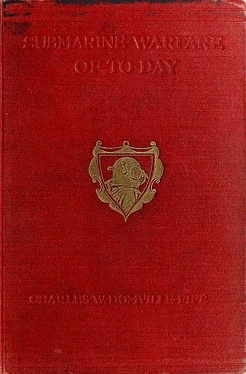The danger of attack from hostile submarines was great, and the gunners stood by their weapons although drenched every few seconds by the floods of heavy spray which still poured over the bows. At last patience and endurance were rewarded. The sea calmed sufficiently to enable a boat to be lowered and with difficulty brought up under the lee of the mysterious ship.
An armed guard, headed by the sub-lieutenant, eagerly scrambled up the lofty rolling sides. They had scarcely reached the deck before their only means of retreat was cut off. The two men left in the life-boat were unable to keep her off the iron sides of the big ship. She rose like a cork on the crest of a wave until almost level with the top line of port-holes and then dropped back, catching the edges of the rolling-stocks. There was a crash of splintering wood and the next minute two half-drowned men were being hauled up the sides by their comrades on deck.
It was an anxious moment, for although the decks seemed deserted there was that curious, uncanny feeling which is ever present when facing an unknown peril. After all it might prove to be a ruse de guerre or some new form of frightfulness. There were only six men from the trawler—a small enough party, however well armed, if it came to a fight—and great caution was observed while exploring the ship. A signal had been arranged in the event of treachery, and the Curlew , with her guns and wireless , would prove a dangerous antagonist.
All was well, however, for the ship was deserted. A careful inspection of the cabins showed that the departure of officers and crew had been a hasty one, but all the ship’s papers had been carefully removed. The forepeak or bow water-tight compartment was full of water, but the bulk-head had held and kept the vessel afloat. Beyond this no damage was visible above the water-line and the condition of both hull and engines was good. She proved to be a Spanish ship, and to make the mystery deeper her four life-boats were still on the davits, although swung outboard ready for lowering.
In those troublous days the fact of the life-boats being hoisted out in readiness for eventualities conveyed little or nothing, but when a careful search proved that many of the life-belts had gone with the crew the problem became an interesting one. Had they been taken on to the deck of a German submarine which had subsequently dived and left them to drown, as was the case with the crew of a British fishing vessel, or had they been conveyed as prisoners of war to Germany? Against both of these surmises was the fact that all the ship’s boats remained, and a German submarine would scarcely be likely to come close alongside even a neutral ship, especially during the bad weather that had prevailed for the past few days. Would it remain one of the many mysteries of the great sea war?
Some few hours later the trawler, with her big “prize”—under her own steam—entered an eastern naval base and berthed her capture with the aid of tugs.
The explanation came from headquarters several weeks later. The s.s. ——, of Barcelona, had grounded on the Goodwins about three hours before she nearly ran down the trawler. Her crew, thinking that she would rapidly break up in the surf, had fired distress signals and been taken safely ashore in a life-boat. The rising tide and south-westerly wind had done the rest, freeing her from the dangerous sands.
CHAPTER XXV
From Out the Clouds and Under-Seas
It has already been shown that the science of aerial warfare is closely allied with that of under-sea fighting. Airships and seaplanes play important parts in all anti-submarine operations. They make very efficient patrols and can detect the presence of both submarines and mines under the surface.
During the Great War there were stations for armed aircraft all round the British coast, and the patrols of the sea and air acted in close co-operation. It often happened that one was able to render important service to the other. An occasion such as this took place off an east coast base in November, 1916.
A big car dashed up the wooden pier of a small seaport regardless of the violent jolting from the uneven planking. It was pulled up with a jerk when level with one of the little grey patrol boats known by the generic name of M.L.’s, which was lying in the calm water alongside with its air compressor pumping vigorously.
Two officers of the Royal Naval Air Service, with a P.O., carrying a powerful Morse signalling lamp, jumped from the car and scrambled down the wooden piles on to the deck of the M.L.
A nod from the commanding officer and the mooring ropes were cast off as the telegraph was jammed over to “half ahead.” Instantly the powerful engines responded to the order and the little ship began rapidly to gather way. When the harbour bar had been crossed the order for full speed was given and the engines settled down to a low staccato roar as they drove the M.L. over the heaving swell.
No word had yet been spoken between the officers of the sea and air. A brief telephone message to the little hut on the quayside from the adjacent naval base to the effect that M.L.A6 was to be ready to embark two officers from the air station and was to proceed in search of an airship which was foundering about twenty miles seawards was all that had been told, and yet not a single second of time was lost in getting under way. All recognised that it was a race to save the lives of men.
The little ship cleft the seas, smothering herself with foam, and bluish fumes poured out of the engine-room ventilators. The first half-hour seemed interminably long, and the horizon was continually searched with the aid of powerful glasses for a sign of the wrecked airship. At last a faint speck became visible away to the south-west, and as the distance slowly lessened—terribly slowly, notwithstanding the speed of nearly half-a-mile a minute—the crumpled envelope settling on the water could be distinguished.
It was a question of minutes. Again the order was shouted down the speaking-tube for more speed, but this time there was no reply. The C.O. rang the telegraph viciously, but without result. The coxswain at the wheel looked up quickly and then shouted an order to a deck hand, who lowered himself down the tiny man-hole in the deck leading to the engine-room. A few seconds later the second engineer appeared at the top of the fo’c’sle hatch and, ducking to avoid a heavy shower of spray, scrambled aft and peered down the man-hole, from which blue fumes, somewhat thicker and more pungent than usual, were rising. The next instant he too disappeared below.
The air officers were trying to get into communication with the rapidly sinking airship by means of the powerful Morse lamp, but without result, and one of them put his head into the wheel-house and asked anxiously if more speed was possible.
Just then the second engineer and one of the crew crawled out of the man-hole, pulling a limp figure behind them. The C.O. turned to ascertain what had happened, and the men, very white and shaky, explained in a few gasps that they had found the chief engineer senseless at the bottom of the iron ladder leading up to the deck, and had themselves been nearly gassed by the petrol fumes.
Glancing at the blue vapour now pouring up the hatchway and out of the ventilators, the C.O. realised the risk of fire and explosion he ran by carrying on at such high speed, but he also knew that men were drowning in the sea some eight miles ahead, and that the few extra knots might make the difference between life and death for them.
That the risk must be taken was a foregone conclusion, but how to keep the engines running at that high speed without attention—for it was evident that no man could live for many minutes in the poisonous fumes—was a more difficult problem. This was solved, however, by the second engineer volunteering to go below with a life-line attached, so that he could be hauled up to the deck when giddiness came on. More than once this gallant petty officer had to be pulled up choking and exhausted. He risked instant death from the explosion of the gas from the leaking and overheated pipes and engines, as well as suffocation from the fumes, but he stuck to his post, returning again and again into the poisonous atmosphere.
Читать дальше












